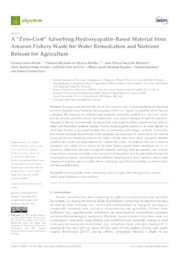A Zero-Cost Adsorbing Hydroxyapatite-Based Material from Amazon Fishery Waste for Water Remediation and Nutrient Release for Agriculture.
A Zero-Cost Adsorbing Hydroxyapatite-Based Material from Amazon Fishery Waste for Water Remediation and Nutrient Release for Agriculture.
Autoria: RENDA, C. G.; RUELLAS, T. M. O.; MALAFATTI, J. O. D.; ARAÚJO, C. S. S.; SILVA, G. L. da; FIGUEIRA, B. A. M.; QUARANTE, S.; PARIS, E. C.
Resumo: This paper puts forward the use of “low-cost/low-end” hydroxyapatite-based adsorbing materials prepared from Tambaqui fish cleaning residues (i.e., bones) by grinding and/or thermal annealing. The nature of raw materials and treatments practically resulted in a “zero-cost” adsorbent for atrazine pesticide and Co2+ ion remediation in an aqueous solution. Despite the distinctive character of the two contaminants, all adsorptions were found to follow pseudo-second order kinetics and Freundlich isotherm models. Pristine hydroxyapatite proved to be more effective in adsorbing atrazine at low concentrations due to interactions with collagen residues. Conversely, heat-treated materials demonstrated better adsorption performances for cobalt due to the removal of organic residues hindering access to the surface. On the other hand, lower adsorption affinities resulted into a faster and more efficient Co2+ release into water. The different behavior in terms of phosphate and cobalt release shown by the three hydroxyapatite-based absorbents can be exploited for differential liberation of targeted nutrients, with high seed germination rates. Considering circular economic principles, waste-derived hydroxyapatites may be potentially attractive for removing ionic species, minimizing water pollution stemming from heavy industry, and for their subsequent targeted release to edible plants, enhancing agricultural availability of mineral nutrients for soil fertilization.
Ano de publicação: 2023
Tipo de publicação: Artigo de periódico
Unidade: Embrapa Instrumentação
Palavras-chave: Amazon region, Circular economy, Fish cleaning waste, Water remediation
Observações
1 - Por padrão são exibidas publicações dos últimos 20 anos. Para encontrar publicações mais antigas, configure o filtro ano de publicação, colocando o ano a partir do qual você deseja encontrar publicações. O filtro está na coluna da esquerda na busca acima.
2 - Para ler algumas publicações da Embrapa (apenas as que estão em formato ePub), é necessário ter, no celular ou computador, um desses softwares gratuitos. Sistemas Android: Google Play Livros; IOS: iBooks; Windows e Linux: software Calibre.
Acesse outras publicações
Acesse a Base de Dados da Pesquisa Agropecuária (BDPA) para consultar o acervo completo das bibliotecas da Embrapa.

